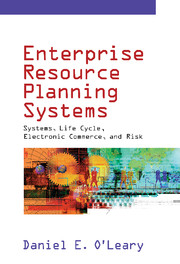Book contents
- Frontmatter
- Contents
- Acknowledgments
- PART ONE INTRODUCTION AND BACKGROUND
- PART TWO ERP SYSTEMS
- PART THREE ERP LIFE CYCLE
- 7 Deciding to Go ERP
- 8 Choosing an ERP System
- 9 Designing ERP Systems: Should Business Processes or ERP Software Be Changed?
- 10 Designing ERP Systems: Choosing Standard Models, Artifacts, and Processes
- 11 Implementing ERP Systems: Big Bang versus Phased
- 12 After Going Live
- 13 Training
- PART FOUR ELECTRONIC COMMERCE AND RISK
- Index
12 - After Going Live
from PART THREE - ERP LIFE CYCLE
Published online by Cambridge University Press: 05 June 2012
- Frontmatter
- Contents
- Acknowledgments
- PART ONE INTRODUCTION AND BACKGROUND
- PART TWO ERP SYSTEMS
- PART THREE ERP LIFE CYCLE
- 7 Deciding to Go ERP
- 8 Choosing an ERP System
- 9 Designing ERP Systems: Should Business Processes or ERP Software Be Changed?
- 10 Designing ERP Systems: Choosing Standard Models, Artifacts, and Processes
- 11 Implementing ERP Systems: Big Bang versus Phased
- 12 After Going Live
- 13 Training
- PART FOUR ELECTRONIC COMMERCE AND RISK
- Index
Summary
After going live with the ERP implementation, it is not time to forget about ERP because it is “done.” Instead, at that time the organization enters a stabilization period that typically drags down organizational performance. As a result, firms need to work to mitigate that negative effect. The firm also needs to build an organization to handle the day-to-day issues associated with the ERP system, and management needs to determine what else must be done and whether the implementation matches the system plan. Also, management must address what upgrades, extensions, or linkages can or should be made to the ERP system. Finally, the firm needs to evaluate the success of the project.
The Stabilization Period
After a system goes live there is what has been referred to as a “stabilization period” that typically lasts from three to nine months. During that period, as noted by a director at Benchmarking Partners, “[m]ost companies should expect some dip in their business performance at the time they go live and should expect that they'll need to manage through that dip” (Koch 1999). For example, a recent survey by Deloitte Consulting found that, after their ERP systems went live, one in four firms suffered some drop in performance.
During the stabilization period, all those processes that once were just plans are now being used. New software and processes may be unfamiliar to the users.
- Type
- Chapter
- Information
- Enterprise Resource Planning SystemsSystems, Life Cycle, Electronic Commerce, and Risk, pp. 172 - 185Publisher: Cambridge University PressPrint publication year: 2000

